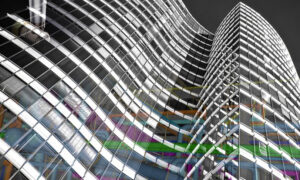Industry veteran Surendra H. Shah explains why it is important to apply air conditioning system judiciously to achieve superior comfort affordably.
Every civilised society in the world has devised its own methods of providing thermal comfort in the built environment for its residents. Two main approaches are active and passive. In cold climates, the commonly used modern active method was by circulating air heated by a central furnace. When refrigeration was introduced, an extra coil in the same system provided the cooling and dehumidification in summer. From these beginnings, air conditioning has become the universally adopted active cooling system. This article examines the suitability of such active systems for hot countries like India and compares them with passive systems evolved by our ancestors and their modern versions that are compatible with the current construction methods.
The popular choice for thermal comfort today is Air Conditioning
Air conditioning uses chilled air in sufficient quantity to remove the heat and moisture gains from the space and maintain its temperature and humidity to specified values. In cold winters the air is heated and humidified. It also provides treated outside air to maintain indoor air quality through ventilation. However, the assumption is that all solar gains, both direct and transmitted, are sensible loads to be absorbed by air and carried away before they reach the occupants.
How air conditioning became popular in the USA?
The primary need in all countries in and above the Temperate zone is heating. All buildings are provided with heating devices for thermal comfort against cold winters. Most popular systems, particularly for houses, are central heating systems circulating warm air heated by a furnace via ducts. The buildings are also well insulated and are well sealed against leakage of heat outwardor infiltration of cold air inward. The idea was to keep the heat in.
When air conditioning became popular, people soon realised that if they merely inserted a cooling coil in the already existing heating system, they could cool their houses in the summer also. It was quite affordable due to mild summers, insulation, and low energy rates. So, air conditioning works well there.
Is air conditioning the right thermal comfort technology for India?
Environment in India is different. Here we have hot summers and our buildings are un-insulated. They absorb the solar heat and pass it inside. So, the interior surfaces get hot and radiate significantly more heat into the conditioned space than do the insulated buildings in the USA. However, we follow the same heat load estimate format that treats all solar transmission gains as sensible load, to be carried away by the circulating air.
Sadly, this is not the case. The radiant load is about 65 watts per square meter. Since air is transparent to this radiation, it can’t intercept it. Thus it directly enters the occupant’s body and adds to its metabolic burden.
Another lacuna is that we are blindly following the American practice of using air for cooling. Its low specific heat combined with its high specific volume make it an ideal medium for heating. Those very properties make it the worst medium for cooling.
Thus, transplanting this American technology results in bulky equipment and a high energy cost. There must be a better answer. To find the answer, we must look at the thermal behaviour of buildings and how their thermal storage capacity actually changes the cooling loads and how it affects the comfort level of the occupants.
Let us start with a simple definition of thermal comfort:
Thermal Comfort
Indoor thermal comfort means that a body can effortlessly remove its metabolic heat from itself and does not receive any from outside. Indoor comfort also requires proper ventilation in order to maintain the indoor air quality.
Body Heat Balance
Most reference books suggest that the metabolic heat load, including the sensible and the latent heat from a human being doing light activity is not more than 150 watts. Various cooling systems have been devised by each civilization, but air conditioning is the most effective system considered today.
Two Studies
Back in the 1960s a team of scientists from CBRI simulated the thermal behaviour of uninsulated buildings in India. They used a scientific calculator (there were no computers then) and actually constructed a building to verify the results. ASHRAE also published a study on how the surrounding environment affects the various routes of heat rejection from clothed men. Both these sources are credible enough to base the study on.
By a simultaneous study of the two
charts, we can draw the following conclusions:
A look at the CBRI chart shows that in India, the indoor building surface temperatures in summer are at or above the human skin temperature during the day and late into the night. A look at the ASHRAE chart will show that under those conditions, a person sitting in still air will be sweating all the time. Since still air could carry very little convective heat, the person will be very uncomfortable. We can also conclude that if the structure is below the body temperature, it will absorb its heat. If it is above, then it will transmit heat to the body, both through radiation.
This proves that heat should not be allowed in if possible. Since the heat comes in due to the hot structure, we must keep it from heating up!
Easier said than done
Several methods are already in use, some are traditional and some modern. Some are more effective than others. Traditional passive methods include shading devices such as trees, verandahs, overhangs etc. Modern passive devices are reflective paint, vermiculite plasters, radiant barriers etc. However, the most effective method uses massive structures like the Taj Mahal to absorb all the solar heat and maintain a stable inside temperature regardless of the weather outside.
Modern active methods include roof sprays, roof ponds, central cooling and heating systems involving circulating water through pipes embedded within the structure. The water is cooled in Summer by a central chiller. There is also a heater for cold seasons.
What if we emulate the Taj Mahal and other massive heritage buildings such as the Gol Gumbaz, Palaces and many others like them? Of course, we can’t build such structures anymore, but we can use modern technology while following the same technique.
Natural cooling process for thermal comfort We, humans have used it for centuries. There is a biological basis choosing cool buildings over cool air for thermal comfort. As homo sapiens, a 40,000-year-old tribe of modern humans, we have lived in caves for 30,000 of them. So the cave is our cradle. We have already adapted to the conditions in the cave. We have adjusted the fat layer under our skin and increased its emissivity to over 95 percent so as to achieve a perfect thermal balance with its cool walls.
Hence the cave should be our natural standard and not some empirical data. Our heritage buildings are prime examples. They provide comfort passively without using any energy. The mountains and our Heritage buildings store the solar heat within their huge mass and keep the interior surfaces below our skin temperature.
How to prevent heat from entering the building?
The roof of a building passively drains out the rainwater by gravity to keep the room dry. Our heritage buildings drain out the heat stored in their hugemass into the attached water bodies or into the sky through radiant cooling. This keeps them thermally stable throughout the year. It is not possible to build them now.
So, the system, described as follows, drains out the heat from modern structures by circulating water to keep it cool. Even the “light” modern buildings have several hundred tonnes mass. So once cool, they will also store considerable solar heat before starting to warm up.
The Basic System
How it works
A pump circulates water from a tank through plastic pipes laid on the cured slab, covered by screed or tiles. The water picks up the roof heat (water absorbs 4100 joules per litre per Deg. C) and passes through a radiator to reject most of it. Lukewarm water is stored in the tank and re-cycled through the radiator at night, when the cool night air absorbs the residual heat. The cycle starts again the next morning.
Energy for the pump and the fan can be supplied by a small PV panel. Thus the system has zero environmental impact.
Disclaimer
This article is not against air conditioning. It is only against its misuse and abuse, which is why we are facing major environmental challenges. Once solar heat is prevented from entering inside, air conditioning can then provide treated, filtered fresh air and meet internal cooling loads very efficiently. Judiciously applied air conditioning system will then provide superior comfort and will be quite affordable.
(The views expressed here are author’s personal. He wishes to thank Roshni Udyawar Yehuda and Sumit Parab for their support and assistance with this report).
Authored by:
Surendra H. Shah Founder & Owner of Panasia Engineers Pvt Ltd, Mumbai Life Member – ISHRAE, IIID and SESI
Cookie Consent
We use cookies to personalize your experience. By continuing to visit this website you agree to our Terms & Conditions, Privacy Policy and Cookie Policy.















